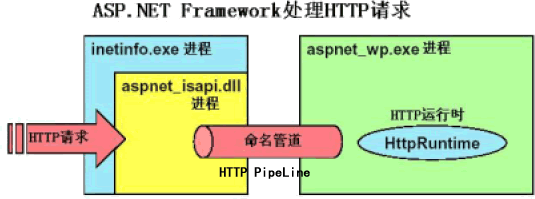Asp.Net生命周期系列三
上文讲到了HttpRunTime主要做了三个事情,我们先回忆一下。
第一:雇佣了项目经理(HttpApplication)。
第二:建立了HttpModule列表,项目经理(HttpRunTime)就是按照这个工作列表去工作的。
第三:创建了Context上下文对象(包含了HttpRequest和HttpResponse两大主要对象),并把它转交给了HttpApplication去处理。
下面最重要的是HttpModule到底是个什么东东,HttpApplication又是怎么样按照它的工作列表去工作的。
当一个请求到达HttpModule时,整个Asp.Net系统并没有对这个Http请求做任何的处理,对于一个Http请求,HttpModule是这个请求的必经之路{Asp.Net内部的处理模型是一个管道流,也就是用户发出一个Http请求一定会从HttpModule这个容器中流过},所以我们可以在Http请求真正到达请求处理中心(HttpHandler)之前,添加一些需要的信息在这个Http请求上、或者针对截获的这个Http请求添加一些额外的工作,再或者干脆终止此次Http请求。可见HttpModule就相当于起到一个Filter过滤器的作用。
1、asp.net的HTTP请求处理过程
说明:
(1)、客户端浏览器向服务器发出一个http请求,此请求会被inetinfo.exe进程 截获,然后转交给aspnet_isapi.dll进程,接着它又通过Http Pipeline的管道,传送给aspnet_wp.exe这个进程,接下来就到了.net framework的HttpRunTime处理中心,处理完毕后就发送给用户浏览器。
(2)、当一个 http请求被送入到HttpRuntime之后,这个Http请求会继续被送入到一个被称之为HttpApplication Factory的一个容器当中,而这个容器会给出一个HttpApplication实例来处理传递进来的http请求,而后这个Http请求会依次进入 到如下几个容器中:HttpModule --> HttpHandler Factory --> HttpHandler。当系统内部的HttpHandler的ProcessRequest方法处理完毕之后,整个Http Request就被处理完成了,客户端也就得到相应的东东了。
(3)完整的http请求在asp.net framework中的处理流程:
HttpRequest-->inetinfo.exe->ASPNET_ISAPI.DLL-->Http Pipeline-->ASPNET_WP.EXE-->HttpRuntime-->HttpApplication Factory-->HttpApplication-->HttpModule-->HttpHandler Factory-->HttpHandler-->HttpHandler.ProcessRequest()
也就是说一个HTTP请求在HttpModule容器的传递过程中,会在某一时刻(ResolveRequestCache事件)将这个HTTP请 求传递给HttpHandler容器。在这个事件之后,HttpModule容器会建立一个HttpHandler的入口实例,但是此时并没有将HTTP 请求控制权交出,而是继续触发AcquireRequestState事件以及PreRequestHandlerExcute事件。在 PreRequestHandlerExcute事件之后,HttpModule窗口就会将控制权暂时交给HttpHandler容器,以便进行真正的 HTTP请求处理工作。
而在HttpHandler容器内部会执行ProcessRequest方法来处理HTTP请求。在容器HttpHandler处理完毕整个 HTTP请求之后,会将控制权交还给HttpModule,HttpModule则会继续对处理完毕的HTTP请求信息流进行层层的转交动作,直到返回到 客户端为止。
2、HttpModule的工作原理
HttpModule实现了IHttpModule接口,我们可以定义自己类实现IHttpModule接口,从而把我们自己定义的HttpModule插入到HttpModule集合中让它成为Http请求的必经之路,以此来添加我们的控制。
asp.net自带的HttpModule如下:具体位置在C:WindowsMicrosoft.NETFrameworkv2.0.50727CONFIG文件中
 View Code
View Code
<httpModules>
<add name="OutputCache" type="System.Web.Caching.OutputCacheModule"/>
<add name="Session" type="System.Web.SessionState.SessionStateModule"/>
<add name="WindowsAuthentication" type="System.Web.Security.WindowsAuthenticationModule"/>
<add name="FormsAuthentication" type="System.Web.Security.FormsAuthenticationModule"/>
<add name="PassportAuthentication" type="System.Web.Security.PassportAuthenticationModule"/>
<add name="RoleManager" type="System.Web.Security.RoleManagerModule"/>
<add name="UrlAuthorization" type="System.Web.Security.UrlAuthorizationModule"/>
<add name="FileAuthorization" type="System.Web.Security.FileAuthorizationModule"/>
<add name="AnonymousIdentification" type="System.Web.Security.AnonymousIdentificationModule"/>
<add name="Profile" type="System.Web.Profile.ProfileModule"/>
<add name="ErrorHandlerModule" type="System.Web.Mobile.ErrorHandlerModule, System.Web.Mobile, Version=2.0.0.0, Culture=neutral, PublicKeyToken=b03f5f7f11d50a3a"/>
<add name="ServiceModel" type="System.ServiceModel.Activation.HttpModule, System.ServiceModel, Version=3.0.0.0, Culture=neutral, PublicKeyToken=b77a5c561934e089"/>
</httpModules>
这里的每个HttpModule在一个Http请求过来时都会流过。
3、我们可以定义自己的HttpModule
要变成HttpModule就必须实现IHttpModule接口,那么我们先来看看IHttpModule接口的内部是什么样的
 View Code
View Code
using System; namespace System.Web { public interface IHttpModule { // 销毁不再被HttpModule使用的资源 void Dispose(); // 初始化一个Module,为捕获HttpRequest做准备 void Init(HttpApplication context); } }
下面是自己定义的HttpModule
 View Code
View Code
using System; using System.Collections.Generic; using System.Linq; using System.Web; namespace ClassLibrary1 { public class MyHttpModel:IHttpModule { public void Dispose() { throw new NotImplementedException(); } public void Init(HttpApplication context) { context.BeginRequest+=new EventHandler(context_BeginRequest); context.EndRequest+=new EventHandler(context_EndRequest); } public void context_BeginRequest(object sender, EventArgs e) { HttpApplication application = sender as HttpApplication; HttpContext context = application.Context; HttpResponse response = context.Response; response.Write("这是自定义的HttpModel中的BeginRequest事件产生的。"); } public void context_EndRequest(object sender, EventArgs e) { HttpApplication application = sender as HttpApplication; HttpContext context = application.Context; HttpResponse response = context.Response; response.Write("这是自定义的HttpModel中的EndRequest事件产生的。"); } } }
置文件如下
<httpModules>
<add name="MyHttpModel" type="ClassLibrary1.MyHttpModel,ClassLibrary1"/>
</httpModules>
请求的Default.aspx.cs文件如下
 View Code
View Code
using System; using System.Collections.Generic; using System.Linq; using System.Web; namespace ClassLibrary1 { public class MyHttpModel:IHttpModule { public void Dispose() { throw new NotImplementedException(); } public void Init(HttpApplication context) { context.BeginRequest+=new EventHandler(context_BeginRequest); context.EndRequest+=new EventHandler(context_EndRequest); } public void context_BeginRequest(object sender, EventArgs e) { HttpApplication application = sender as HttpApplication; HttpContext context = application.Context; HttpResponse response = context.Response; response.Write("这是自定义的HttpModel中的BeginRequest事件产生的。"); } public void context_EndRequest(object sender, EventArgs e) { HttpApplication application = sender as HttpApplication; HttpContext context = application.Context; HttpResponse response = context.Response; response.Write("这是自定义的HttpModel中的EndRequest事件产生的。"); } } }
具体运行结果如下:
今天就写到这里吧,文章页有些长了,不过HttpModule还没有介绍完呢,如果您对我的文章感兴趣的话请继续关注我的下篇,下篇我们将继续介绍HttpModule这个东东的。
本系列:
